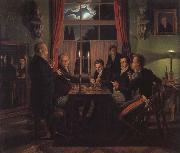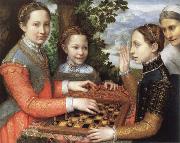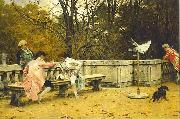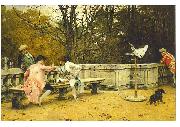Wholesale Oil Painting No Minimum |
|||||||||||
|
|
|||||||||||

|
|||||||||||
|
|
|
||||||||
Johann Erdmann Hummel1769 Kassel-1852 Berlin,German painter and writer. He studied from 1782 in the architecture class at the Akademie der Bildenden K?nste at Kassel and subsequently under the Kassel court painter, Wilhelm B?ttner. Hummel retained his connection with architecture, however, and this is manifested in his overpowering concern with structure and perspective. The Kassel court granted Hummel funds for travel and study in Italy and, in 1792, he went to Rome, where he joined a group of fellow Germans, including the painters Johann Christian Reinhart, Johann Martin von Rohden, Friedrich Bury and the architect Friedrich Weinbrenner. In 1796 Joseph Anton Koch joined the group. Hummel also attended the philosophical lectures given by Carl Ludwig Fernow (1763-1808) and became a friend of the archaeologist Aloys Hirt. In Rome, |
||||||||
|
|
||||||||
The Chess Game
The Chess Game Painting ID:: 38590 |
mk138
1818/19
Oil on canvas
38.5x44cm
mk138 1818/19 Oil on canvas 38.5x44cm |
|||||||
|
|
||||||||
Sofonisba AnguissolaItalian 1532-1625 Sofonisba Anguissola was born in Cremona, Lombardy around 1532, the oldest of seven children, six of whom were daughters. Her father, Amilcare Anguissola, was a member of the Genoese minor nobility. Sofonisba's mother, Bianca Ponzone, was also of an affluent family of noble background. Her mother died when Sofonisba was four or five. Over four generations, the Anguissola family had a strong connection to ancient Carthaginian history and they named their offspring after the great general Hannibal, thus the first daughter was named after the tragic Carthaginian figure Sophonisba. Amilcare Anguissola encouraged all of his daughters (Sofonisba, Elena, Lucia, Europa, Minerva and Anna Maria) to cultivate and perfect their talents. Four of the sisters (Elena, Lucia, Europa and Anna Maria) became painters, but Sofonisba was by far the most accomplished and renowned. Elena became a nun (Sofonisba painted a portrait of her) and had to quit painting. Both Anna Maria and Europa gave up art upon marrying, while Lucia Anguissola, the best painter of Sophonisba's sisters, died young. The other sister, Minerva, became a writer and Latin scholar. Asdrubale, Sophonisba's brother, studied music and Latin but not painting. Self-portrait, 1554Her aristocratic father made sure that Sofonisba and her sisters received a well-rounded education that included the fine arts. Anguissola was fourteen years old when her father sent her with her sister Elena to study with Bernardino Campi, a respected portrait and religious painter of the Lombard school, also from Cremona, Sofonisba's home town. When Campi moved to another city, Sofonisba continued her studies with the painter Bernardino Gatti (known as Il Sojaro). Sofonisba's apprenticeship with local painters set a precedent for women to be accepted as students of art.[citation needed] Dates are uncertain, but Anguissola probably continued her studies under Gatti for about three years(1551-1553). Sophonisba's most important early work is Bernardino Campi Painting Sofonisba Anguissola (c 1550 Pinacoteca Nazionale, Siena). The double portrait depicts her art teacher in the act of painting a portrait of her. In 1554, at age twenty-two, Sofonisba traveled to Rome, where she spent her time sketching various scenes and people. While in Rome, she met Michelangelo through the help of another painter who knew her work well. Meeting Michelangelo was a great honor for Sofonisba and she had the benefit of being informally trained by the great master. Lucia, Minerva and Europa Anguissola Playing Chess, 1555. Museum Navrodwe, Poznan, Poland.When he made a request for her to draw a weeping boy, Sofonisba drew 'Child bitten by a crab' and sent it back to Michelangelo, who immediately recognized her talent (this sketch would continue to be discussed and copied for the next fifty years among artists and the aristocracy) Michelangelo subsequently gave Anguissola sketches from his notebooks to draw in her own style and offered advice on the results. For at least two years Sofonisba continued this informal study, receiving substantial guidance from Michelangelo. |
||||||||
|
|
||||||||
|
|
the chess game
the chess game Painting ID:: 56022 |
mk247
1555,oil on canvas,28.375x38.128 in,72x97 cm,muzeum narodowe,poznan,poland mk247 1555,oil on canvas,28.375x38.128 in,72x97 cm,muzeum narodowe,poznan,poland |
||||||
|
|
||||||||
Charles Bargue(c. 1826/1827?CApril 61883) was a French artist, a lithographer as well as a painter, who devised a drawing course. Charles Bargue is mostly remembered for his Cours de dessin, one of the most influential classical drawing courses conceived in collaboration with Jean-L??on G??rôme. The course, published between 1866 and 1871 by Goupil & Cie, and composed of 197 lithographs printed as individual sheets, was to guide students from plaster casts to the study of great master drawings and finally to drawing from the living model. Among the artists whose work is based on the study of Bargue's platework, is Vincent van Gogh who copied the complete set in 1880/1881, and (at least a part of it) again in 1890. |
||||||||
|
|
||||||||
|
|
The Chess Game
The Chess Game Painting ID:: 85940 |
16.5x23.3 cm.
Date published 19th century
cjr 16.5x23.3 cm. Date published 19th century cjr |
||||||
|
|
||||||||
Charles Bargue(c. 1826/1827?CApril 61883) was a French artist, a lithographer as well as a painter, who devised a drawing course. Charles Bargue is mostly remembered for his Cours de dessin, one of the most influential classical drawing courses conceived in collaboration with Jean-L??on G??rôme. The course, published between 1866 and 1871 by Goupil & Cie, and composed of 197 lithographs printed as individual sheets, was to guide students from plaster casts to the study of great master drawings and finally to drawing from the living model. Among the artists whose work is based on the study of Bargue's platework, is Vincent van Gogh who copied the complete set in 1880/1881, and (at least a part of it) again in 1890. |
||||||||
|
|
||||||||
|
|
The Chess Game
The Chess Game Painting ID:: 90124 |
oil on panel. Original size (neat lines): 16.5x23.3 cm.
Date published 19th century
cyf oil on panel. Original size (neat lines): 16.5x23.3 cm. Date published 19th century cyf |
||||||
|
|
||||||||
|
Charles Bargue (c. 1826/1827?CApril 61883) was a French artist, a lithographer as well as a painter, who devised a drawing course. Charles Bargue is mostly remembered for his Cours de dessin, one of the most influential classical drawing courses conceived in collaboration with Jean-L??on G??rôme. The course, published between 1866 and 1871 by Goupil & Cie, and composed of 197 lithographs printed as individual sheets, was to guide students from plaster casts to the study of great master drawings and finally to drawing from the living model. Among the artists whose work is based on the study of Bargue's platework, is Vincent van Gogh who copied the complete set in 1880/1881, and (at least a part of it) again in 1890. The Chess Game oil on panel. Original size (neat lines): 16.5x23.3 cm. Date published 19th century cyf |
||||||||
|
|
||||||||
|
Prev Next
|
||||||||
|
|
||||||||
|
Related Paintings to Charles Bargue :. |
||||||||
|
|
||||||||
|
CONTACT US |




